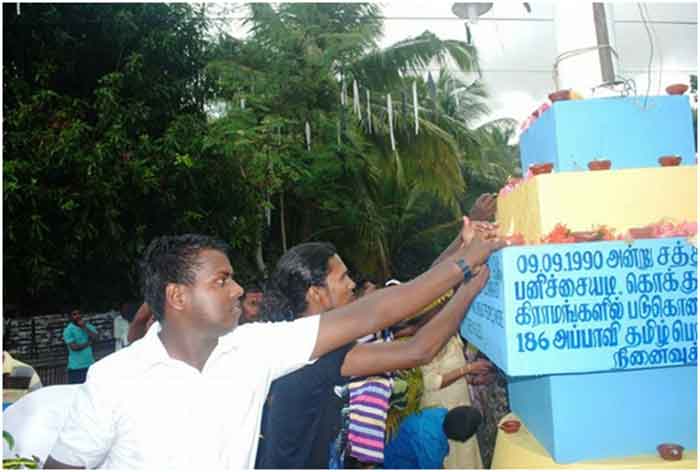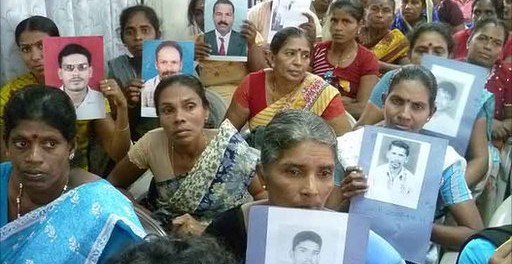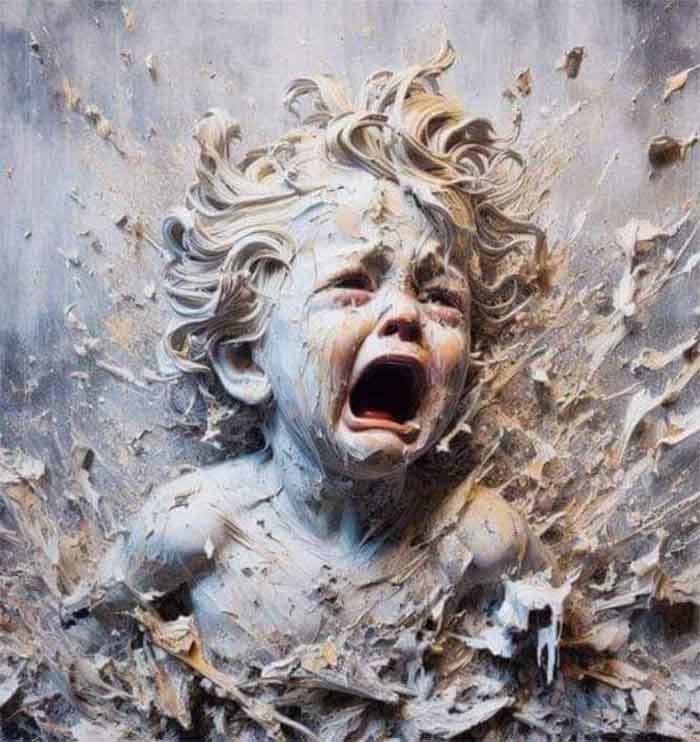
On 5 September 1990. Sri Lanka army units arrested 158 Tamil civilians who sought shelter in the temporary refugee camp inside the premises of the Eastern University during military operations in the area.
All of of them were tortured and killed, according to a one man commission that investigated the massacre three years later. Although the commission named several perpetrators of the massacre, the Sri Lankan government took no action to investigate or bring them to book.
Four days later on 9 September 184 Tamils from Sathurukondan and its surroundings, on the northern outskirts of Batticaloa town, were arrested and hacked to death in the local SLA camp. Again, Colombo took no action despite damning evidence by a youth who escaped the mass murder with machete wounds.
September 9, 1990, 5.30 pm. Armed men clad in military uniform and civilian clothes instruct people from Sathurukondan, Kokkuvil, Pachchaiyadi and Pillayaradi to come out to the road. They are taken to the Bois Town military camp nearby with the assurance that they will be released after questioning. They were mostly the elderly, women and children. None of them returned to their homes. In total, 184 individuals were massacred.
The list of victims totaled 184 (38 Sathurukondan, 47 Kokuvil, 37 Panniachchiady and 62 Pillayarady). Of this number, there were 47 children below the age of 10 and several women
Human rights activists and Tamil civil society leaders say more than six thousand Tamils were murdered by Sri Lanka army and its paramilitaries between August and December 1990 in the Batticaloa-Amparai districts alone.
Retired judge K. Palakidnar of the Special Presidential Commission of inquiry appointed by the People’s Alliance government described the massacre in detail in his final report. According to the report of the commission of inquiry, 5 infants, 42 children under ten, 85 women and 28 old persons were among the 184 villagers who were murdered. The judge also identified three captains of the Sri Lankan Army: Warnakulasooriya, Herath and Wijenaike as the responsible parties. The judge in his report urged the Sri Lankan President that there is strong evidence for the massacre and that legal action should be taken against the perpetrators. Although indictment leveled against alleged miscreants by the Human Rights Task Force, no action has been taken against the alleged perpetrators.
Within the Batticaloa district, during the late 1980s and early 1990s a total of 1,100 civilians disappeared, assumed killed.
Two human rights commissions appointed by the UNP and the PA respectively said categorically that the Sri Lanka army was responsible for the massacre. Justice Souza who headed the first commission named a Sri Lanka army officer and a member of a paramilitary group as the main culprits in the university massacre. The retired justice identified the SLA officer as Capt. Richard Dias, Sinhalese who operated under the Muslim alias ‘Munas’.
But none of the perpetrators named by the commissions were brought to book.
Dr. Kingsley Swamipillai, who was then the Bishop of Trincomalee and Batticaloa and a member of the Batticaloa Peace Committee, went to the massacre the following day, along with the military personnel. “Everything had been set on fire but there were heads and body parts that were not fully burnt.” Bishop Swamipillai told Maatram.
Colonel Percy Fernando, who accompanied the Bishop, had said, “We are very saddened. It is our people who did this. Therefore, I should apologize.”
Kumarathasan Rasingam– Secretary, Tamil Canadian Elders for Human Rights Org.















































